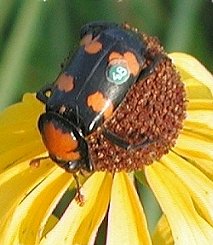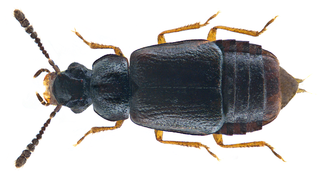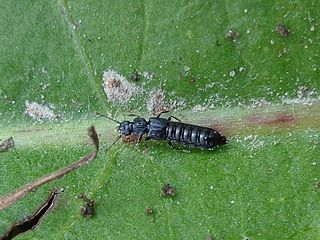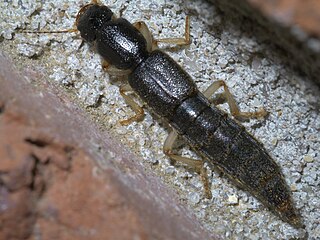
The rove beetles are a family (Staphylinidae) of beetles, primarily distinguished by their short elytra that typically leave more than half of their abdominal segments exposed. With over 66,000 species in thousands of genera, the group is one of the largest families in the beetle order, and one of the largest families of organisms. It is an ancient group that first appeared during the Middle Jurassic based on definitive records of fossilized rove beetles, with the Late Triassic taxon Leehermania more likely belonging to Myxophaga. They are an ecologically and morphologically diverse group of beetles, and commonly encountered in terrestrial ecosystems.

Pselaphinae are a subfamily of beetles in the family Staphylinidae, the rove beetles. The group was originally regarded as a separate family named Pselaphidae. Newton and Thayer (1995) placed them in the Omaliine group of the family Staphylinidae based on shared morphological characters.

Nicrophorini is a tribe of burying beetles or carrion beetles in the subfamily Silphinae. It was formerly treated as subfamily Nicrophorinae within family Silphidae, but this family was found to be nested in family Staphylinidae in phylogenetic analyses and Silphidae was reassigned as a subfamily Staphylinidae.

The Paederinae are a subfamily of the Staphylinidae, rove beetles. As of 2024, three tribes are accepted within this subfamily: Lathrobiini, Paederini, and Pinophilini. This insect is commonly known as Tomcat.

Dasycerinae is a subfamily of rove beetles. Dasycerinae currently only contains 1 extant genus and 3 extinct genera.

The Euaesthetinae are a subfamily of the Staphylinidae (Coleoptera) containing six tribes.

The Oxytelinae are a subfamily of the Staphylinidae, rove beetles. There are about 20 genera and at least 320 described species in Oxytelinae.

Bledius is a genus of spiny-legged rove beetles in the family Staphylinidae. There are at least 100 described species in Bledius.

Hoplandriini is a tribe of rove beetles in the family Staphylinidae. There are at least 5 genera and 21 described species in Hoplandriini.

Eusphalerum is a genus of ocellate rove beetles in the family Staphylinidae. There are at least 130 described species in Eusphalerum.

Anthophagini is a tribe of ocellate rove beetles in the family Staphylinidae. There are at least 20 genera and 20 described species in Anthophagini.

Micropeplus is a genus of rove beetles in the family Staphylinidae. There are at least 40 described species in Micropeplus.

Omalium is a genus of ocellate rove beetles in the family Staphylinidae. There are at least 70 described species in Omalium.

Omaliini is a tribe of ocellate rove beetles in the family Staphylinidae. There are about 45 genera and 450 described species in Omaliini.

Pelecomalium is a genus of ocellate rove beetles in the family Staphylinidae. There are at least three described species in Pelecomalium.

Phloeonomus is a genus of ocellate rove beetles in the family Staphylinidae. There are about eight described species in Phloeonomus.

Trigonurus is a genus of rove beetles in the family Staphylinidae, the only family of the subfamily Trigonurinae. There are about nine described species in Trigonurus, found in the Holarctic.

Oxytelini is a tribe of spiny-legged rove beetles in the family Staphylinidae. There are about 11 genera and at least 20 described species in Oxytelini.

Pinophilini is a tribe of rove beetles in the family Staphylinidae.
Omalorphanus is monotypic genus of beetles in the family Staphylinidae, the rove beetles, where it is placed in the subfamily Omaliinae. The only species is Omalorphanus aenigma. The genus and the species were described by John Milton Campbell and Donald S. Chandler in 1987 from the H.J. Andrews Experimental Forest (Oregon) at elevations of 3,500 feet (1,100 m) to 4,000 feet (1,200 m). It was described by them as unusual for its number of unusual morphological features, which made the placement of the species difficult.





















